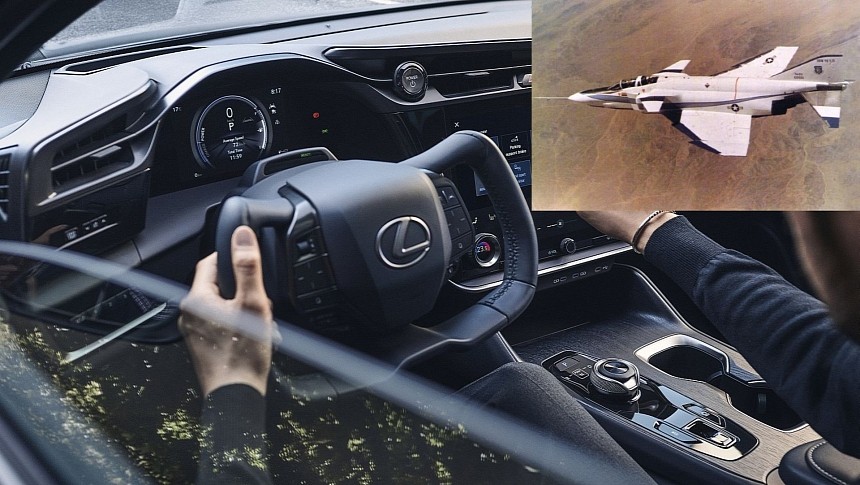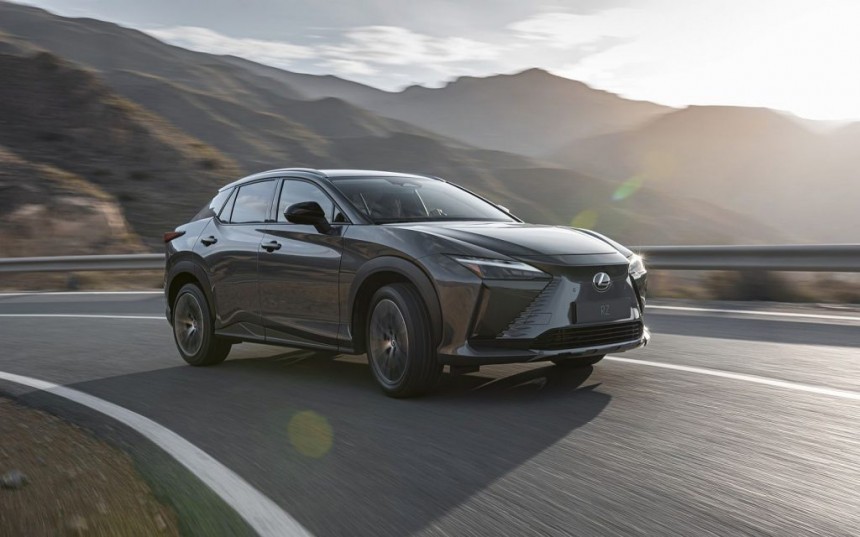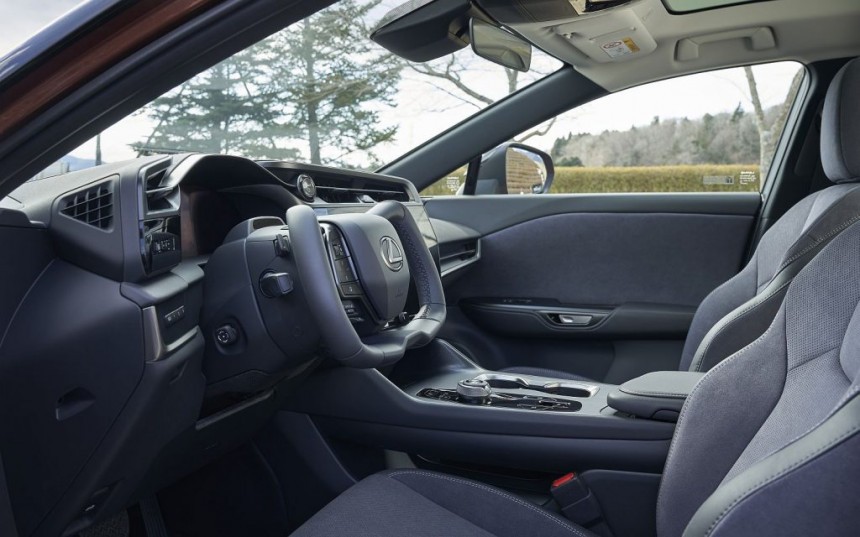When it comes to the all-new, all-electric Lexus RZ, it's easy to get the impression things are a bit of a hit-or-miss affair, with the whole novel EV drivetrain shoved into what looks like a typical Lexus RX and all. But what isn't in question, at least not anymore, is how cool and interesting the top-spec variant's steer-by-wire system paired with a Tesla-like steering yoke as an option. The regular steering wheel will also be part of the offer.
Though still in its prototype phase, a single pre-production unit was given to Jason Fenske of the Engineering Explained YouTube channel to check out what's on offer. As Jason worked through the finer points of Lexus' electronic servo-operated, steer-by-wire system, it's easy for anyone who's aerospace inclined to start making comparisons to systems found in airplanes. But to understand the differences and similarities between steer-by-wire systems in cars and fly-by-wire in modern jets, we need to know why engineers would even want to replace mechanical linkages with computer-controlled sensors and actuators in the first place.
In regard to aviation specifically, fly-by-wire controls were historically implemented with cutting-edge designs on the breaking edge of innovation in some way. The first known instance of an aircraft whose control surfaces were manipulated not through physical linkages but remote-controlled servos and actuators was an icon in its own right, the Soviet Tupolev ANT-20. But you might know it by its propaganda name, the Maxim Gorky.
With a wingspan, in 1934, that almost matches that of a Boeing 747, it makes perfect sense why Tupolev would rather not fit several miles of wires and cables for the ANT-20's vast control surfaces.This same spirit of ambition was behind the first non-experimental usage of fly-by-wire controls on an aircraft, the Avro Canada CF-105 Arrow. A plane hailed as one of the fastest, most maneuverable, and most capable jet fighters of the 1950s. Had it not been canceled, the Arrow would have spent its days hunting down Soviet bombers trying to infiltrate North American airspace over the Arctic before they even got close.
Other noteworthy aircraft from this period that employed fly-by-wire systems without physical connections between the flight stick and the control surfaces include Concorde. As the first passenger airliner capable of cracking twice the speed of sound, are you starting to sense a pattern here? It's that any airframe on the knife's-edge of technology benefits from non-mechanical flight controls when the limits of human reaction times are pushed beyond their limits in some way. Whether from raw speed or raw size, it's become a stalwart of a great many modern airplanes military or civilian.
What does any of this have to do with Lexus' steer-by-wire? Well, Jason Fenske's conversation with Lexus engineer Yushi Higashiyama on Engineering Explained shed considerable light on why the auto industry would bother with such aerospace-adjacent technology. To paraphrase, we all know that modern all-electric drivetrains can make equivalent ICE-powered vehicles look slow by comparison. As the industry gravitates ever more towards electric cars jetting sub-three and even sub-two-second zero to 60 times, the industry is facing much the same issue as the aerospace sector back in the late 1950s. A time when jet fighters were pushing boundaries in ways never seen before.
Indeed, it's nothing short of astonishing how engineers 60 years ago, without the benefit of modern computers or AutoCAD software, were able to design a fly-by-wire system that, at its core, works uncannily similar to what Lexus just came up with in 2023. Of course, the end result, whether in the air or on the pavement, is very similar. In both instances, computer-operated control schemes manipulated by remote sensors and actuators can provide considerably more feedback and response with less hand movement than physical steering boxes, or flight control surfaces can manage on their own.
It's this remarkable ability to actively adapt steering ratios to suit the needs of driving conditions that's a cornerstone of Lexus' steer-by-wire system. No need to worry about a twitchy driving experience a la an F1 car when driving down the highway at high speeds due to a tight steering ratio. Lexus' novel steering control actuator can tailor the steering performance to whatever speed or road conditions its driver is liable to come across on the average morning commute. Of course, it might be a bit silly driving to work with a steering wheel shaped like it's better suited in an airliner than in an electric crossover.
But where most people found the steering yoke in a Tesla Model S or Model X Plaid to be obnoxious and gimmicky, Jason Fenske seemed to find Lexus' take on a steering yoke to be far more clever. Mostly because hand-over-hand steering in a Tesla Plaid is more anxiety-inducing than the morning before a math test. But this isn't a problem when Lexus' steer-by-wire ratio can automatically adapt so that hand-over-hand turns need not be a problem anymore.
It's hard not to admire Lexus for brazenly forging a new path in automotive innovation when the rest of the industry seemed perfectly content with the status quo. Of course, Lexus' steer-by-wire system isn't completely foolproof. The first round of production copies of the Lexus RZ will even be shipped with traditional mechanical steering linkages before subsequent models ship out with steer-by-wire systems and sci-fi-adjacent steering yokes. Even so, it's not hard to get the sense Lexus really is onto something here.
It must be said initial critical responses to Lexus' new steering setup have been somewhat mixed. Engineering Explained was quick to point out how marvelous a feat of technology Lexus manages to cram into their RZ 450e crossover, built on the e-TNGA architecture. But by the same token, they also pointed out that when the steering wheel was photographed twice in the same position, the position of the wheels on the road between the two photographs seemed to be different. In general, the consensus from the press at large seems to point to a similar sentiment. A marvelous leap in technology Lexus steer-by-wire may be, but the implementation might need some more work.
But if that's the case right now, how good will the system be three to five years down the line? Could we really see a day when traditional steering linkages and steering boxes go the way of the dodo in new electric cars? That seems to be the line of thinking Lexus is bringing to the party. So don't be surprised if, at some point very soon, the rest of the auto industry starts implementing their own proprietary steer-by-wire systems.
If this is the case, and computers and servos really are better than mechanical systems one day, we'll probably look back at Lexus and call them the trendsetters that got the ball rolling in the first place. By the same token, it's just another way the world of automobiles was blessed with a leap in technology that found its beginnings in aerospace. But somehow, we don't think the aviation industry is going to be barking up Lexus' doorstep looking for royalties checks or anything like that. Although that would be pretty funny, admittedly.
Check out Engineering Explained's video review of the Lexus RZ 450e prototype down below if you want to learn more and check back soon for more automotive and aviation profiles and so much more on autoevolution.
In regard to aviation specifically, fly-by-wire controls were historically implemented with cutting-edge designs on the breaking edge of innovation in some way. The first known instance of an aircraft whose control surfaces were manipulated not through physical linkages but remote-controlled servos and actuators was an icon in its own right, the Soviet Tupolev ANT-20. But you might know it by its propaganda name, the Maxim Gorky.
With a wingspan, in 1934, that almost matches that of a Boeing 747, it makes perfect sense why Tupolev would rather not fit several miles of wires and cables for the ANT-20's vast control surfaces.This same spirit of ambition was behind the first non-experimental usage of fly-by-wire controls on an aircraft, the Avro Canada CF-105 Arrow. A plane hailed as one of the fastest, most maneuverable, and most capable jet fighters of the 1950s. Had it not been canceled, the Arrow would have spent its days hunting down Soviet bombers trying to infiltrate North American airspace over the Arctic before they even got close.
Other noteworthy aircraft from this period that employed fly-by-wire systems without physical connections between the flight stick and the control surfaces include Concorde. As the first passenger airliner capable of cracking twice the speed of sound, are you starting to sense a pattern here? It's that any airframe on the knife's-edge of technology benefits from non-mechanical flight controls when the limits of human reaction times are pushed beyond their limits in some way. Whether from raw speed or raw size, it's become a stalwart of a great many modern airplanes military or civilian.
Indeed, it's nothing short of astonishing how engineers 60 years ago, without the benefit of modern computers or AutoCAD software, were able to design a fly-by-wire system that, at its core, works uncannily similar to what Lexus just came up with in 2023. Of course, the end result, whether in the air or on the pavement, is very similar. In both instances, computer-operated control schemes manipulated by remote sensors and actuators can provide considerably more feedback and response with less hand movement than physical steering boxes, or flight control surfaces can manage on their own.
It's this remarkable ability to actively adapt steering ratios to suit the needs of driving conditions that's a cornerstone of Lexus' steer-by-wire system. No need to worry about a twitchy driving experience a la an F1 car when driving down the highway at high speeds due to a tight steering ratio. Lexus' novel steering control actuator can tailor the steering performance to whatever speed or road conditions its driver is liable to come across on the average morning commute. Of course, it might be a bit silly driving to work with a steering wheel shaped like it's better suited in an airliner than in an electric crossover.
But where most people found the steering yoke in a Tesla Model S or Model X Plaid to be obnoxious and gimmicky, Jason Fenske seemed to find Lexus' take on a steering yoke to be far more clever. Mostly because hand-over-hand steering in a Tesla Plaid is more anxiety-inducing than the morning before a math test. But this isn't a problem when Lexus' steer-by-wire ratio can automatically adapt so that hand-over-hand turns need not be a problem anymore.
It must be said initial critical responses to Lexus' new steering setup have been somewhat mixed. Engineering Explained was quick to point out how marvelous a feat of technology Lexus manages to cram into their RZ 450e crossover, built on the e-TNGA architecture. But by the same token, they also pointed out that when the steering wheel was photographed twice in the same position, the position of the wheels on the road between the two photographs seemed to be different. In general, the consensus from the press at large seems to point to a similar sentiment. A marvelous leap in technology Lexus steer-by-wire may be, but the implementation might need some more work.
But if that's the case right now, how good will the system be three to five years down the line? Could we really see a day when traditional steering linkages and steering boxes go the way of the dodo in new electric cars? That seems to be the line of thinking Lexus is bringing to the party. So don't be surprised if, at some point very soon, the rest of the auto industry starts implementing their own proprietary steer-by-wire systems.
If this is the case, and computers and servos really are better than mechanical systems one day, we'll probably look back at Lexus and call them the trendsetters that got the ball rolling in the first place. By the same token, it's just another way the world of automobiles was blessed with a leap in technology that found its beginnings in aerospace. But somehow, we don't think the aviation industry is going to be barking up Lexus' doorstep looking for royalties checks or anything like that. Although that would be pretty funny, admittedly.



















